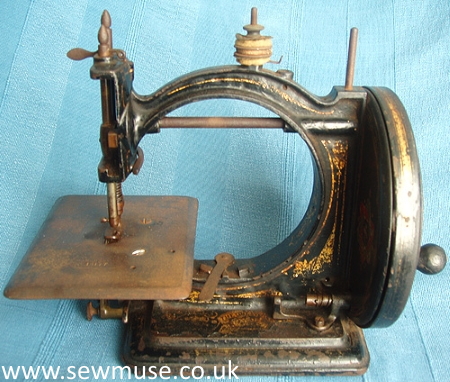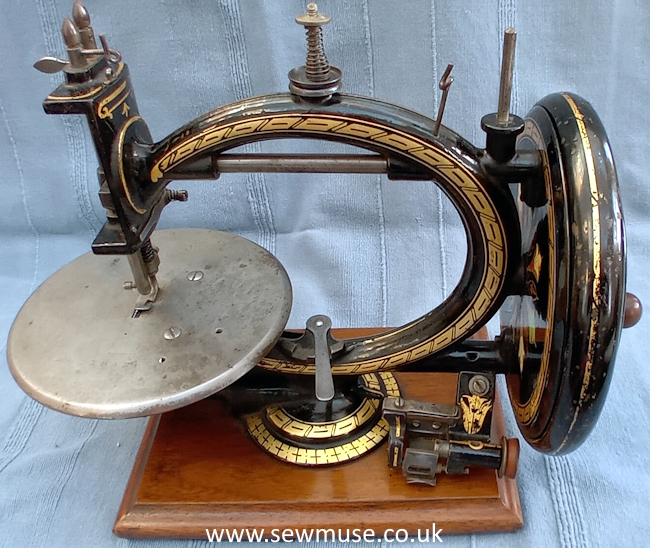The Company was founded by John Spier Heron, James Gresham and Thomas Craven in 1869 and initially trade as Gresham & Co. it later became Heron, Grsham & Craven.
Due to ill health J. S. Heron left the company in April 1875 and the firm became known as Gresham & Craven. Later c1879 a Singer principle machine known as The Heron was produced.
As well as sewing machines the company manufactured a Patent woven wire mattress, Improved Giffard's Injectors for steam boilers, vacuum brake and other equipment for trains.
c1884 after approximately 32,000 sewing machines had been produced the firm focused on its other engineering projects.

The Gresham Serial No.18177.
This machine was manufactured c1873. On the cloth plate is stamped Patent March 1867 Heron Gresham Craven followed by the machines serial number.
The needle bar is open and the lever on the base operates the reverse stitch mechanism. The base decal reads The Gresham and has the letters H,G,C intertwined with Manchester beneath.
The company re engineered the machine and produced the Improved Gresham, which is known to have been in production by 1877 although production of The Gresham continued.
The Gresham Serial No.24074.
Another example of the Gresham which was manufactured after April 1875 as only Gresham and Craven are named on the cloth plate.
On the base instead of an intertwined H,G,C, it is now just C & G.
There are subtle differences from the machine above - the bobbin winder, tension and balance wheel have all been modified.
Note in particular the cast decoration as well as the raised boss at the 7 0'clock position on the balance wheel. This was provided ready for the mechanism to allow the balance wheel to be disengaged for bobbin winding a feature which was introduced prior to October 1876.
The hole at the 1 o'clock position is for the handle which was missing on this machine.
The Daco (Improved Gresham)
Serial No.28621.
Around 1877 Gresham & Craven redesigned the Gresham replacing the "I" frame with a round frame whilst retaining the basic mechanics. A new bobbin winder was introduced and it had a fast & loose balance wheel.
The new machine was designated The Improved Gresham however the company continued to produce both versions until it ceased sewing machine production in the mid 1880's.

This particular Improved Gresham may well be unique as it has a circular clothplate (rather than the usual square one) which has been engraved - Rylands & Sons Ltd The Daco Sewing Machine.
There is also the image of a man holding a scythe with the motto "Not the Last" underneath. This was one of a number of Trademarks the company registered and this particular one was still in use in 1926.
The engraving is quite worn and pitted which makes some of the details difficult to pick out but it's most unusual and if anyone can provide more information about what the engraving represents I'd be interested to learn more.


Rylands & Sons was founded by Joseph Rylands and his 3 sons - John, Joseph & Richard in Wigan in 1819 manufacturing Linen. In 1842 John Rylands became the sole proprititor concentrating on cotton manufacture and he rapidly became the largest textile merchant in Great Britain.
Rylands & Sons became a Limited company in 1873 and by 1877 the company owned 17 cotton mills with some 12,000 employees. It survived into the C20th being taken over by Great Universal Stores in 1953 before finally closing in 1971.
Shown above is the balance wheel with the lever at the 11 O'clock position to allows bobbins to be wound without turning the stitching mechanism.
The machine is quite stunning with much of the pattern still intact. The lever in the centre facilitates reverse sewing.
As the machine was labeled the Daco Sewing Machine a needlebar cover was not fitted.












